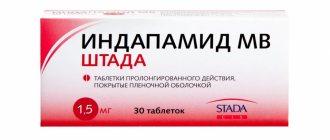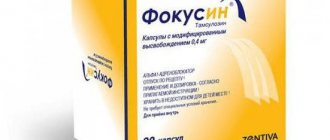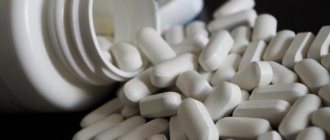GLICLAZIDE (Gliclazidum)
Hypoglycemia
When taking sulfonylurea derivatives, including gliclazide, hypoglycemia may develop, in some cases severe and prolonged, requiring hospitalization and intravenous dextrose solution for several days.
Gliclazide can be prescribed only to those patients whose meals are regular and include breakfast. It is very important to maintain a sufficient intake of carbohydrates from food, since the risk of developing hypoglycemia increases with irregular or insufficient nutrition, as well as in the case of eating foods low in carbohydrates.
Hypoglycemia is more likely to occur during a low-calorie diet, after prolonged or vigorous exercise, after drinking alcohol, or when taking multiple hypoglycemic drugs at the same time.
Typically, symptoms of hypoglycemia go away after eating a meal rich in carbohydrates (such as sugar). It should be borne in mind that taking sweeteners does not help eliminate hypoglycemia. Experience with other sulfonylureas suggests that hypoglycemia may recur despite initial effective relief. If the symptoms of hypoglycemia are pronounced or prolonged, even if the condition improves temporarily after eating a meal rich in carbohydrates, emergency medical care is necessary, including hospitalization.
To avoid the development of hypoglycemia, careful individual selection of drugs and dosage regimen is necessary, as well as providing the patient with complete information about the treatment being carried out.
An increased risk of hypoglycemia may occur in the following cases:
- refusal or inability of the patient (especially the elderly) to follow doctor’s orders and control their condition;
- insufficient and irregular nutrition, skipping meals, fasting and changes in diet;
- imbalance between physical activity and the amount of carbohydrates taken;
- renal failure;
- severe liver failure;
- overdose of gliclazide;
- some endocrine disorders: thyroid diseases, pituitary and adrenal insufficiency;
- simultaneous use of certain medications.
Kidney and liver failure
In patients with hepatic impairment and/or severe renal impairment, the pharmacokinetic and/or pharmacodynamic properties of gliclazide may be altered. The state of hypoglycemia that develops in such patients can be quite long-lasting; in such cases, immediate appropriate therapy is necessary.
Insufficient glycemic control
Glycemic control in patients treated with hypoglycemic agents may be impaired in the following cases: fever, trauma, infectious diseases, or major surgery. In these conditions, it may be necessary to discontinue gliclazide therapy and prescribe insulin therapy.
In many patients, the effectiveness of oral hypoglycemic drugs, including gliclazide, tends to decrease after a long period of treatment. This effect may be due to both disease progression and a decrease in the therapeutic response to gliclazide. This phenomenon is known as secondary drug resistance, which must be distinguished from primary resistance, in which the drug does not produce the expected clinical effect even at the first use. Before diagnosing secondary drug resistance in a patient, it is necessary to assess the adequacy of dose selection and the patient's compliance with the prescribed diet.
Laboratory tests
To assess glycemic control, regular determination of fasting blood glucose and HbAlc concentrations is recommended. In addition, it is advisable to regularly self-monitor blood glucose concentrations. Sulfonylureas may cause hemolytic anemia in patients with glucose-6-phosphate dehydrogenase deficiency. Since gliclazide is a sulfonylurea derivative, caution must be exercised when prescribing it to patients with glucose-6-phosphate dehydrogenase deficiency. The possibility of prescribing a hypoglycemic drug from another group should be considered.
Patient Information
It is necessary to inform the patient, as well as his family members, about the risk of developing hypoglycemia, its symptoms and conditions that contribute to its development. The patient must be informed of the potential risks and benefits of the proposed treatment.
The patient must be explained the importance of diet, the need for regular exercise and monitoring blood glucose concentrations.
Dysglycemia (changes in blood glucose concentration)
Changes in blood glucose concentrations, including hypoglycemia and hyperglycemia, have been reported in patients with T2DM receiving concomitant therapy with fluoroquinolones, especially in elderly patients. Blood glucose concentrations should be carefully monitored in all patients receiving gliclazide and a fluoroquinolone concomitantly.
Patients with porphyria
Cases of acute porphyria have been described with the use of other sulfonylureas in patients with porphyria.
Gliclazide MV Pharmstandard, 60 mg, extended-release tablets, 30 pcs.
Gliclazide MB modified release tablets 30 mg are taken orally once daily with breakfast. For patients who have not previously received treatment, the initial dose is 30 mg (including for persons over 65 years of age). Then the dose is selected individually until the desired therapeutic effect is achieved.
Dose selection should be carried out in accordance with the blood glucose level after the start of treatment. Each subsequent dose change may be attempted after a minimum period of two weeks. The daily dose of the drug can vary from 30 mg (1 tablet) to 90-120 mg (3-4 tablets). The daily dose should not exceed 120 mg (4 tablets).
Gliclazide MB can replace gliclazide regular-release tablets (80 mg) in doses of 1 to 4 tablets per day. If you miss one or more doses of the drug, you should not take a higher dose at the next dose (the next day).
When replacing another hypoglycemic drug with Gliclazide MB 30 mg tablets, no transition period is required. You must first complete your daily dose of another drug and only start taking this drug the next day.
If the patient has previously received therapy with sulfonylurea drugs with a longer half-life, then careful monitoring (monitoring blood glucose levels) for 1-2 weeks is necessary to avoid hypoglycemia as a consequence of the residual effects of previous therapy.
Gliclazide MB tablets can be used in combination with biguanides, alpha-glucosidase inhibitors or insulin.
For patients with mild to moderate renal failure, the drug is prescribed in the same doses as for patients with normal renal function. In severe renal failure, Gliclazide MB tablets are contraindicated.
Patients at risk of developing hypoglycemia.
In patients at risk of developing hypoglycemia (insufficient or unbalanced nutrition, severe or poorly compensated endocrine disorders - pituitary and adrenal insufficiency, hypothyroidism, withdrawal of GCS after long-term use and/or use in high doses, severe diseases of the cardiovascular system ( severe coronary heart disease, severe atherosclerosis of the carotid arteries, widespread atherosclerosis), it is recommended to use the minimum dose (30 mg) of the drug Gliclazide MB.
Gliclazide MB
THE DRUG IS INTENDED FOR USE ONLY IN ADULTS
The recommended dose of the drug should be taken orally, 1 time/day, preferably during breakfast.
The daily dose is 30-120 mg (½-2
tablets) in 1 dose. It is recommended to swallow the entire dose of the drug whole, without chewing or crushing.
If you miss one or more doses of the drug, you cannot take a higher dose at the next dose; the missed dose should be taken the next day. As with other hypoglycemic drugs, the dose of the drug in each case must be selected individually, depending on the concentration of blood glucose and glycosylated hemoglobin (HbAlc).
Initial dose
The initial recommended dose in adults who have not previously received treatment (including elderly people ≥65 years of age) is 30 mg/day (½ tablet), then the dose is adjusted individually until the desired result is achieved.
Dose selection
An increase in the dose is possible no earlier than after 1 month of drug therapy at the previously prescribed dose. The exception is patients whose blood glucose concentrations have not decreased within two weeks of therapy. In such cases, the dose of the drug can be increased at the end of the second week of treatment. Each subsequent dose change can be made after at least a two-week period.
Maintenance therapy
The maintenance daily dose ranges from 30 mg to 90-120 mg. The maximum recommended daily dose is 120 mg. The presence of a notch on the 60 mg tablet allows you to divide the tablet and take a daily dose equal to either 30 mg (½ 60 mg tablet) or, if necessary, 90 mg (1 ½ 60 mg tablets).
Switching from taking gliclazide, 80 mg tablets
1 tablet of gliclazide 80 mg is equivalent ½
modified release tablets 60 mg of the drug Gliclazide MB. When transferring a patient from taking gliclazide 80 mg tablets to therapy with Gliclazide MB, careful glycemic control is recommended.
Switching from therapy with another oral hypoglycemic drug
The drug Gliclazide MB can be used instead of another oral hypoglycemic agent. When transferring patients from therapy with another oral hypoglycemic preirate to therapy with extended-release gliclazide, it is necessary to take into account the effectiveness, dose and duration of action of the previously used hypoglycemic agent. Typically no transition period is required. The initial dose of extended-release gliclazide should be 30 mg per day, then the dose is adjusted by titration under monitoring blood glucose concentrations.
When transferring a patient from therapy with hypoglycemic drugs with a longer T1/2, it may be necessary to temporarily (for several days) discontinue treatment to avoid an additive effect that increases the risk of hypoglycemia. The initial dose of extended-release gliclazide in this case should also be 30 mg per day. If necessary, the dose can be further increased by titration under the control of blood glucose concentration.
Combination therapy with other hypoglycemic agents
Gliclazide MB can be used in combination with biguanides, alpha-glucosidase inhibitors or insulin.
Elderly people
Recommended doses of the drug for elderly people are identical to those for adults under 65 years of age.
Kidney failure
Recommended doses of the drug for mild to moderate renal failure are identical to those for individuals with normal renal function. Close medical monitoring of the patient is recommended.
Patients at risk of developing hypoglycemia
In patients at risk of developing hypoglycemia (insufficient or unbalanced nutrition; severe or poorly compensated endocrine disorders - pituitary and adrenal insufficiency, hypothyroidism; withdrawal of GCS after prolonged use and/or use in high doses; severe diseases of the cardiovascular system ( severe coronary heart disease, severe atherosclerosis of the carotid arteries, widespread atherosclerosis), it is recommended to use the minimum dose (30 mg) of Gliclazide MB.
Prevention of complications of diabetes mellitus
To achieve intensive glycemic control, the dose of Gliclazide MB can be gradually increased to 120 mg/day in addition to diet and exercise until the target HbAlc is achieved. The risk of hypoglycemia should be remembered. In addition, other hypoglycemic drugs, such as metformin, an alpha-glucosidase inhibitor, a hyazolidinedione derivative, or insulin, can be added to therapy.
Gliclazide Canon (30mg, 60mg)
When taking sulfonylurea derivatives, including gliclazide, hypoglycemia may develop, and in some cases in a severe and prolonged form, requiring hospitalization and intravenous administration of a dextrose solution for several days.
The drug Gliclazide Canon can be prescribed only to those patients whose meals are regular and include breakfast. It is very important to maintain a sufficient intake of carbohydrates from food, because... The risk of developing hypoglycemia increases with irregular or insufficient nutrition, as well as with consumption of foods low in carbohydrates. Hypoglycemia is more likely to occur during a low-calorie diet, after prolonged or vigorous exercise, after drinking alcohol, or when taking multiple hypoglycemic medications at the same time.
Typically, symptoms of hypoglycemia go away after eating a meal rich in carbohydrates (such as sugar). It should be borne in mind that taking sweeteners does not help eliminate hypoglycemic symptoms. Experience with other sulfonylureas suggests that hypoglycemia may recur despite initial effective management of the condition. If hypoglycemic symptoms are pronounced or prolonged, even if the condition improves temporarily after eating a meal rich in carbohydrates, emergency medical care is necessary, including hospitalization.
To avoid the development of hypoglycemia, careful individual selection of drugs and dosage regimen is necessary, as well as providing the patient with complete information about the proposed treatment.
An increased risk of hypoglycemia may occur in the following cases:
- refusal or inability of the patient (especially the elderly) to follow doctor’s orders and control their condition;
- insufficient and irregular nutrition, skipping meals, fasting and changes in diet;
- imbalance between physical activity and the amount of carbohydrates taken;
- renal failure;
- severe liver failure;
- overdose of the drug Gliclazide Canon;
- some endocrine disorders (thyroid diseases, pituitary and adrenal insufficiency);
- simultaneous use of certain medications.
Sulfonylureas may cause hemolytic anemia in patients with glucose-6-phosphate dehydrogenase deficiency. Since gliclazide is a sulfonylurea derivative, caution must be exercised when prescribing it to patients with glucose-6-phosphate dehydrogenase deficiency. The possibility of prescribing a hypoglycemic drug of another group should be assessed.
Liver/renal failure
In patients with severe hepatic and/or renal insufficiency, the pharmacokinetic and/or pharmacodynamic properties of gliclazide may change. The hypoglycemia that develops in these patients can be quite long-lasting; in such cases, immediate appropriate therapy is necessary.
Patient Information
It is necessary to inform the patient and his family about the risk of developing hypoglycemia, its symptoms and conditions that contribute to its development. The patient must be informed of the potential risks and benefits of the proposed treatment. The patient should be taught the importance of diet, the need for regular exercise, and regular monitoring of blood glucose concentrations.
Insufficient glycemic control
Glycemic control in patients treated with hypoglycemic agents may be impaired in the following situations: fever, trauma, infectious diseases, or major surgery. In these conditions, it may be necessary to stop therapy with Gliclazide Canon and prescribe insulin therapy. In many patients, the effectiveness of oral hypoglycemic agents, incl. gliclazide tends to decrease after a long period of treatment. This effect may be due to both progression of the disease and a decrease in the therapeutic response to the drug. This phenomenon is known as secondary drug resistance, which must be distinguished from primary resistance, in which the drug does not give the expected clinical effect even at the first prescription. Before diagnosing secondary drug resistance in a patient, it is necessary to assess the adequacy of dose selection and compliance with the prescribed diet.
Control of laboratory parameters
To assess glycemic control, regular determination of fasting blood glucose and glycosylated hemoglobin concentrations is recommended. In addition, it is advisable to regularly self-monitor blood glucose concentrations.
Impact on the ability to drive vehicles and machinery
Patients should be aware of the symptoms of hypoglycemia and exercise caution when driving or performing work that requires high psychomotor speed, especially at the beginning of therapy.


